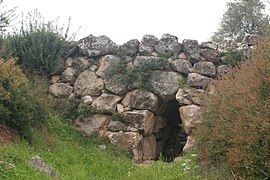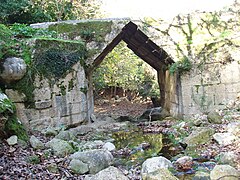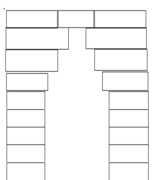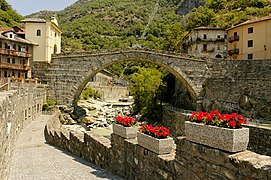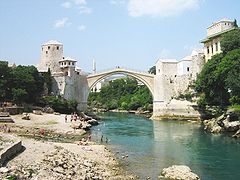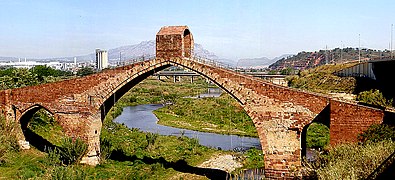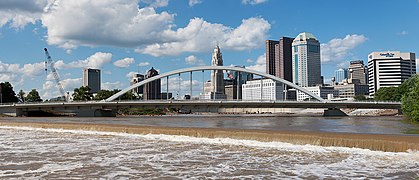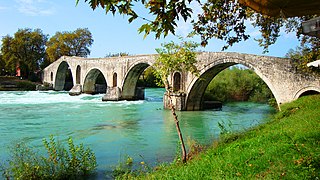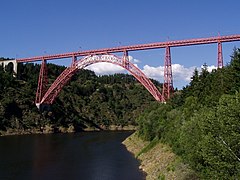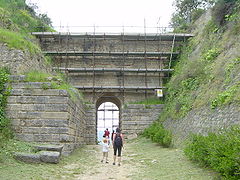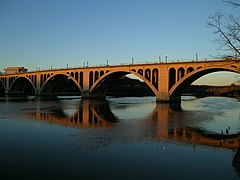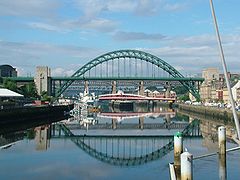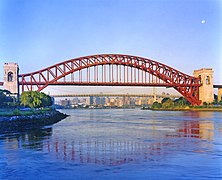A | B | C | D | E | F | G | H | CH | I | J | K | L | M | N | O | P | Q | R | S | T | U | V | W | X | Y | Z | 0 | 1 | 2 | 3 | 4 | 5 | 6 | 7 | 8 | 9
 A double-arch stone bridge in Nagasaki, Japan | |
| Ancestor | Clapper bridge |
|---|---|
| Descendant | Truss arch bridge, moon bridge (masonry) |
| Carries | Pedestrians, vehicles, light rail, heavy rail, water |
| Span range | short, but often set end-to-end to form a large total length |
| Material | masonry, concrete, wrought iron, cast iron, timber, structural steel |
| Movable | No |
| Design effort | Low |
| Falsework required | Yes |
An arch bridge is a bridge with abutments at each end shaped as a curved arch. Arch bridges work by transferring the weight of the bridge and its loads partially into a horizontal thrust restrained by the abutments at either side. A viaduct (a long bridge) may be made from a series of arches, although other more economical structures are typically used today.
History
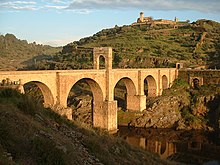

Possibly the oldest existing arch bridge is the Mycenaean Arkadiko Bridge in Greece from about 1300 BC. The stone corbel arch bridge is still used by the local populace.[1] The well-preserved Hellenistic Eleutherna Bridge has a triangular corbel arch.[2] The 4th century BC Rhodes Footbridge rests on an early voussoir arch.[3]
Although true arches were already known by the Etruscans and ancient Greeks, the Romans were – as with the vault and the dome – the first to fully realize the potential of arches for bridge construction.[4] A list of Roman bridges compiled by the engineer Colin O'Connor features 330 Roman stone bridges for traffic, 34 Roman timber bridges and 54 Roman aqueduct bridges, a substantial part still standing and even used to carry vehicles.[5] A more complete survey by the Italian scholar Vittorio Galliazzo found 931 Roman bridges, mostly of stone, in as many as 26 countries (including former Yugoslavia).[6]
Roman arch bridges were usually semicircular, although a number were segmental arch bridges (such as Alconétar Bridge), a bridge which has a curved arch that is less than a semicircle.[7] The advantages of the segmental arch bridge were that it allowed great amounts of flood water to pass under it, which would prevent the bridge from being swept away during floods and the bridge itself could be more lightweight.[8] Generally, Roman bridges featured wedge-shaped primary arch stones (voussoirs) of the same in size and shape. The Romans built both single spans and lengthy multiple arch aqueducts, such as the Pont du Gard and Segovia Aqueduct. Their bridges featured from an early time onwards flood openings in the piers, e.g. in the Pons Fabricius in Rome (62 BC), one of the world's oldest major bridges still standing.
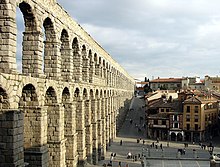
Roman engineers were the first and until the industrial revolution the only ones to construct bridges with concrete, which they called Opus caementicium. The outside was usually covered with brick or ashlar, as in the Alcántara bridge.
The Romans also introduced segmental arch bridges into bridge construction. The 330 m-long (1,080 ft) Limyra Bridge in southwestern Turkey features 26 segmental arches with an average span-to-rise ratio of 5.3:1,[9] giving the bridge an unusually flat profile unsurpassed for more than a millennium. Trajan's bridge over the Danube featured open-spandrel segmental arches made of wood (standing on 40 m-high (130 ft) concrete piers). This was to be the longest arch bridge for a thousand years both in terms of overall and individual span length, while the longest extant Roman bridge is the 790 m-long (2,590 ft) long Puente Romano at Mérida. The late Roman Karamagara Bridge in Cappadocia may represent the earliest surviving bridge featuring a pointed arch.[10]
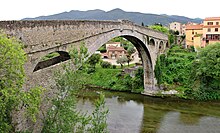
In medieval Europe, bridge builders improved on the Roman structures by using narrower piers, thinner arch barrels and higher span-to-rise ratios on bridges. Gothic pointed arches were also introduced, reducing lateral thrust, and spans increased as with the eccentric Puente del Diablo (1282).
The 14th century in particular saw bridge building reaching new heights. Span lengths of 40 m (130 ft), previously unheard of in the history of masonry arch construction, were now reached in places as diverse as Spain (Puente de San Martín), Italy (Castelvecchio Bridge) and France (Devil's bridge and Pont Grand) and with arch types as different as semi-circular, pointed and segmental arches. The bridge at Trezzo sull'Adda, destroyed in the 15th century, even featured a span length of 72 m (236 ft), not matched until 1796.[11]

Constructions such as the acclaimed Florentine segmental arch bridge Ponte Vecchio (1345) combined sound engineering (span-to-rise ratio of over 5.3 to 1) with aesthetical appeal. The three elegant arches of the Renaissance Ponte Santa Trinita (1569) constitute the oldest elliptic arch bridge worldwide. Such low rising structures required massive abutments, which at the Venetian Rialto bridge and the Fleischbrücke in Nuremberg (span-to-rise ratio 6.4:1) were founded on thousands of wooden piles, partly rammed obliquely into the grounds to counteract more effectively the lateral thrust.

In China, the oldest existing arch bridge is the Zhaozhou Bridge of 605 AD, which combined a very low span-to-rise ratio of 5.2:1, with the use of spandrel arches (buttressed with iron brackets). The Zhaozhou Bridge, with a length of 167 feet (51 m) and span of 123 feet (37 m), is the world's first wholly stone open-spandrel segmental arch bridge, allowing a greater passage for flood waters.[12] Bridges with perforated spandrels can be found worldwide, such as in China (Zhaozhou Bridge, 7th century). Greece (Bridge of Arta, 17th century) and Wales (Cenarth Bridge, 18th century).
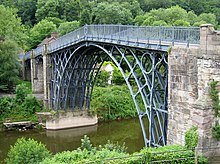
In more modern times, stone and brick arches continued to be built by many civil engineers, including Thomas Telford, Isambard Kingdom Brunel and John Rennie. A key pioneer was Jean-Rodolphe Perronet, who used much narrower piers, revised calculation methods and exceptionally low span-to-rise ratios. Different materials, such as cast iron, steel and concrete have been increasingly used in the construction of arch bridges.
Simple compression arch bridges
Advantages of simple materials


Stone, brick and other such materials are strong in compression and somewhat so in shear, but cannot resist much force in tension. As a result, masonry arch bridges are designed to be constantly under compression, so far as is possible. Each arch is constructed over a temporary falsework frame, known as a centring. In the first compression arch bridges, a keystone in the middle of the bridge bore the weight of the rest of the bridge. The more weight that was put onto the bridge, the stronger its structure became. Masonry arch bridges use a quantity of fill material (typically compacted rubble) above the arch in order to increase this dead-weight on the bridge and prevent tension from occurring in the arch ring as loads move across the bridge. Other materials that were used to build this type of bridge were brick and unreinforced concrete. When masonry (cut stone) is used the angles of the faces are cut to minimize shear forces. Where random masonry (uncut and unprepared stones) is used they are mortared together and the mortar is allowed to set before the falsework is removed.
Traditional masonry arches are generally durable, and somewhat resistant to settlement or undermining. However, relative to modern alternatives, such bridges are very heavy, requiring extensive foundations. They are also expensive to build wherever labor costs are high.
Construction sequence

- Where the arches are founded in a watercourse bed (on piers or banks) the water is diverted so the gravel can first be excavated and replaced with a good footing (of strong material). From these, the foundation piers are erected/raised to the height of the intended base of the arches, a point known as the springing.
- Falsework centering (in British English: arch frame) is fabricated, typically from timbers and boards. Since each arch of a multi-arch bridge will impose a thrust upon its neighbors, it is necessary either that all arches of the bridge be raised at the same time, or that very wide piers be used. The thrust from the end arches is taken into the earth by substantial (vertical) footings at the canyon walls, or by large inclined planes forming in a sense ramps to the bridge, which may also be formed of arches.
- The several arches are (or single arch is) constructed over the centering. Once each basic arch barrel is constructed, the arches are (or arch is) stabilized with infill masonry above, which may be laid in horizontal running bond courses (layers). These may form two outer walls, known as the spandrels, which are then infilled with appropriate loose material and rubble.
- The road is paved and parapet walls protectively confine traffic to the bridge.
Types of arch bridge
Corbel arch bridge
-
Corbel arch built from Cyclopean masonry, in the Greek Arkadiko bridge
-
Corbel arch in the shape of an isosceles triangle, supporting the Greek Eleutherna Bridge
-
A corbelled arch with the masonry untrimmed
-
A corbel arch with the masonry cut into an arch shape
The corbel arch bridge is a masonry, or stone, bridge where each successively higher course (layer) cantilevers slightly more than the previous course.[13] The steps of the masonry may be trimmed to make the arch have a rounded shape.[14] The corbel arch does not produce thrust, or outward pressure at the bottom of the arch, and is not considered a true arch. It is more stable than a true arch because it does not have this thrust. The disadvantage is that this type of arch is not suitable for large spans.[15]
Aqueducts and canal viaducts
- Aqueducts and canal viaducts
-
Roman Pont-Saint-Martin
-
The three-story Roman Pont du Gard aqueduct
-
The Roman segmental arch Bridge at Limyra
In some locations it is necessary to span a wide gap at a relatively high elevation, such as when a canal or water supply must span a valley. Rather than building extremely large arches, or very tall supporting columns (difficult using stone), a series of arched structures are built one atop another, with wider structures at the base. Roman civil engineers developed the design and constructed highly refined structures using only simple materials, equipment, and mathematics. This type is still used in canal viaducts and roadways as it has a pleasing shape, particularly when spanning water, as the reflections of the arches form a visual impression of circles or ellipses.
Deck arch bridge
- Deck arch bridges
-
Diagram of an open-spandrel deck arch bridge
-
Grosvenor Bridge (Chester), a closed-spandrel arch bridge
-
Alexander Hamilton Bridge, an open-spandrel arch bridge
-
Galena Creek Bridge, a cathedral arch bridge
This type of bridge comprises an arch where the deck is completely above the arch. The area between the arch and the deck is known as the spandrel. If the spandrel is solid, usually the case in a masonry or stone arch bridge, the bridge is called a closed-spandrel deck arch bridge. If the deck is supported by a number of vertical columns rising from the arch, the bridge is known as an open-spandrel deck arch bridge. The Alexander Hamilton Bridge is an example of an open-spandrel arch bridge. Finally, if the arch supports the deck only at the top of the arch, the bridge is called a cathedral arch bridge.[16]
Through arch bridge

This type of bridge has an arch whose base is at or below the deck, but whose top rises above it, so the deck passes through the arch. The central part of the deck is supported by the arch via suspension cables or tie bars, as with a tied-arch bridge. The ends of the bridge may be supported from below, as with a deck arch bridge. Any part supported from arch below may have spandrels that are closed or open.
The Sydney Harbour Bridge and the Bayonne Bridge are a through arch bridge which uses a truss type arch.
Tied-arch bridge
Also known as a bowstring arch, this type of arch bridge incorporates a tie between two opposite ends of the arch. The tie is usually the deck and is capable of withstanding the horizontal thrust forces which would normally be exerted on the abutments of an arch bridge.
The deck is suspended from the arch. The arch is in compression, in contrast to a suspension bridge where the catenary is in tension. A tied-arch bridge can also be a through arch bridge.
-
The deck of the Fremont Bridge goes through the arch, the central span is suspended from and ties the arch, while the side spans of the deck are supported.
Hinged arch bridge
An arch bridge with hinges incorporated to allow movement between structural elements. A single-hinged bridge has a hinge at the crown of the arch, a two-hinged bridge has hinges at both springing points and a three-hinged bridge has hinged in all three locations.[17]
Gallery
This section contains an unencyclopedic or excessive gallery of images. |
- Different types of arch bridges
-
Pointed arch of the Puente del Diablo in Spain
-
Alte Nahebrücke (c.1300) supports buildings on its piers
-
Krämerbrücke (1325) – longest continuously inhabited bridge in Europe.
-
Ponte Santa Trinita. First bridge with elliptic arches
-
A masonry moon bridge showing the buttressing approach ramps that take the horizontal thrust of the arch
-
Fredrikstad bridge in Fredrikstad, Norway
-
The Main Street Bridge in Columbus, OH is the only inclined-arch suspension bridge in North America.
-
The Garabit Viaduct is a wrought iron truss arch bridge.
-
The dry stone bridge, so called Porta Rosa (4th century BC), in Elea, Province of Salerno, Campania, Italy (2005)
-
Bridge in Český Krumlov, Czech Republic (2004)
-
Union Arch Bridge carrying the Washington Aqueduct and MacArthur Boulevard (formerly named Conduit Road), Cabin John, Montgomery County, Maryland, U.S.A. (2008)
-
Woodrow Wilson Bridge carrying Interstate 95 (I-95) and the Capital Beltway over the Potomac River between Alexandria, Virginia and Oxon Hill, Maryland, U.S.A. (2007)
-
Daxi River Bridge of Jinhua–Wenzhou High Speed Railway
Use of modern materials
Most modern arch bridges are made from reinforced concrete. This type of bridge is suitable where a temporary centring may be erected to support the forms, reinforcing steel, and uncured concrete. When the concrete is sufficiently set the forms and falseworks are then removed. It is also possible to construct a reinforced concrete arch from precast concrete, where the arch is built in two halves which are then leaned against each other.
Many modern bridges, made of steel or reinforced concrete, often bear some of their load by tension within their structure. This reduces or eliminates the horizontal thrust against the abutments and allows their construction on weaker ground. Structurally and analytically they are not true arches but rather a beam with the shape of an arch. See truss arch bridge for more on this type.
A modern evolution of the arch bridge is the long-span through arch bridge. This has been made possible by the use of light materials that are strong in tension such as steel and prestressed concrete.
See also
Footnotes
- ^ Hellenic Ministry of Culture: Mycenaean bridge at Kazarma Archived 8 April 2008 at the Wayback Machine
- ^ Nakassis, Athanassios (2000): "The Bridges of Ancient Eleutherna", The Annual of the British School at Athens, Vol. 95, pp. 353–365
- ^ Galliazzo 1995, p. 36; Boyd 1978, p. 91
- ^ Robertson, D.S.: Greek and Roman Architecture, 2nd edn., Cambridge 1943, p. 231:
"The Romans were the first builders in Europe, perhaps the first in the world, fully to appreciate the advantages of the arch, the vault and the dome."
- ^ O'Connor, Colin: "Roman Bridges", Cambridge University Press 1993, p. 187ff. ISBN 0-521-39326-4
- ^ Galliazzo, Vittorio (1994), I ponti romani. Catalogo generale, Vol. 2, Treviso: Edizioni Canova, ISBN 88-85066-66-6, cf. Indice
- ^ Beall, Christine (1988). "Designing the segmental arch" (PDF). ebuild.com. Retrieved 8 May 2010.
- ^ Temple, Robert. The Genius of China: 3,000 Years of Science, Discovery, and Invention. New York: Touchstone, 1986.
- ^ O'Connor, Colin: "Roman Bridges", Cambridge University Press 1993, p. 126 ISBN 0-521-39326-4
- ^ Galliazzo 1995, pp. 92, 93 (fig. 39)
- ^ Troyano, Leonardo Fernández: Bridge Engineering. A Global Perspective, Thomas Telford Publishing, London 2003, ISBN 0-7277-3215-3, p. 49
- ^ Needham, Joseph. The Shorter Science and Civilisation in China. Cambridge University Press, 1994. ISBN 0-521-29286-7. pp. 145–147.
- ^ Richman, Steven M. (2005), The Bridges of New Jersey, Rutgers University Press, p. 23, ISBN 978-0-8135-3510-4
- ^ Harris, Cyril M. (1983), Illustrated Dictionary of Historic Architecture, Courier Dover Publications, p. 137, ISBN 978-0-486-24444-0
- ^ Simpson, Frederick Moore (1913), A history of architectural development, Longmans, Green, and Co., p. 25
- ^ Durski, Brad F. (Winter 2010). "Nevada's Galena Creek Bridge" (PDF). Aspire. Precast/Prestressed Concrete Institute. Archived from the original (PDF) on 16 February 2010. Retrieved 18 June 2012.
- ^ Reynolds, Charles E.; Steedman, James C.; Threlfall, Anthony J. (7 August 2007). Reinforced Concrete Designer's Handbook, Eleventh Edition. CRC Press. p. 41. ISBN 978-0-203-08775-6.
References
- Boyd, Thomas D. (1978), "The Arch and the Vault in Greek Architecture", American Journal of Archaeology, 82 (1): 83–100 (91), doi:10.2307/503797, JSTOR 503797, S2CID 194040597
- Galliazzo, Vittorio (1995), I ponti romani, vol. 1, Treviso: Edizioni Canova, ISBN 88-85066-66-6
- Galliazzo, Vittorio (1994), I ponti romani. Catalogo generale, vol. 2, Treviso: Edizioni Canova, ISBN 88-85066-66-6
- O’Connor, Colin (1993), Roman Bridges, Cambridge University Press, p. 129, ISBN 0-521-39326-4
- Proske, Dirk (2009), Safety of historical stone arch bridges, Springer, p. 336, ISBN 978-3-540-77616-1
External links
>Text je dostupný pod licencí Creative Commons Uveďte autora – Zachovejte licenci, případně za dalších podmínek. Podrobnosti naleznete na stránce Podmínky užití.
File:NagasakiMeganebashi.jpg
Megane Bridge
Nagasaki
Clapper bridge
Truss arch bridge
Moon bridge
Pedestrian
Vehicle
Light rail
Heavy rail
Masonry
Concrete
Wrought iron
Cast iron
Timber
Structural steel
Falsework
Abutment
Arch
Structural load
Viaduct
List of Roman bridges
List of medieval stone bridges in Germany
List of medieval bridges in France
File:Bridge Alcantara.JPG
Alcántara Bridge
File:Anji (Zhaozhou) Bridge 2011.jpg
Anji Bridge
Mycenaean Greece
Arkadiko Bridge
Corbel arch
Hellenistic
Eleutherna Bridge
Rhodes Footbridge
Voussoir
True arch
Etruscans
Ancient Greeks
Ancient Rome
Vault (architecture)
Dome
Roman bridge
List of Roman bridges#Masonry bridges
List of Roman bridges#Timber and stone pillar bridges
List of Roman bridges#Aqueduct bridges
Yugoslavia
Semicircular
Alconétar Bridge
Circular segment
Voussoir
Roman aqueducts
Pont du Gard
Segovia Aqueduct
Pons Fabricius
File:AcueductoSegovia edit1.jpg
Segovia Aqueduct
Industrial revolution
Roman concrete
Opus caementicium
Ashlar
Limyra Bridge
Turkey
Trajan's bridge
Danube
Spandrel
Puente Romano
Mérida, Spain
Karamagara Bridge
Cappadocia
File:Pont du Diable - Céret.JPG
Pont du Diable (Céret)
Céret
Medieval
Pier (architecture)
Gothic architecture
Puente del Diablo (Martorell)
Puente de San Martín
Castelvecchio Bridge
Pont du Diable (Céret)
Pont Grand (Tournon-sur-Rhône)
Trezzo sull'Adda Bridge
File:Firenze.Ponte Vecchio01.jpg
Ponte Vecchio
Florence
Florence
Ponte Vecchio
Renaissance
Ponte Santa Trinita
Abutment
Venice
Rialto bridge
Fleischbrücke
Nuremberg
File:Richmond Bridge Panorama Restitch.jpg
Richmond Bridge (Tasmania)
Zhaozhou Bridge
Zhaozhou Bridge
Bridge of Arta
Cenarth Bridge
File:Ironbridge 6.jpg
The Iron Bridge
Thomas Telford
Isambard Kingdom Brunel
John Rennie (father)
Jean-Rodolphe Perronet
Cast iron
Steel
Concrete
File:MonroeStreetBridgea.jpg
Centering
Monroe Street Bridge (Spokane River)
Spokane, Washington
File:Vanha kivisilta DSC08273 C.JPG
Kerava River
Kerava
Finland
Compression (physical)
Shearing (physics)
Tension (mechanics)
Falsework
Centring
Keystone (architecture)
Settlement (construction)
Foundation (architecture)
File:Limyra Bridge Workflow.gif
Limyra Bridge
Pier (architecture)
Centering
Running bond
Parapet
Corbel arch
File:Arkadiko2.jpg
Cyclopean masonry
Arkadiko bridge
File:Eleutherna Bridge, Crete, Greece. Pic 03.jpg
Isosceles triangle
Eleutherna Bridge
File:Corbelledarch.png
File:Trabeate Arch in New Delhi India.jpg
Corbel arch
True arch
True arch
File:Pont romain-Pont st Martin.jpg
Pont-Saint-Martin (bridge)
File:Pont du Gard BLS.jpg
Pont du Gard
Aqueduct (watercourse)
File:Limyra Bridge Arch.svg
Bridge at Limyra
Civil engineering
File:Arch bridge nomenclature.png
File:Grosvenor Bridge Chester4.JPG
Grosvenor Bridge (Chester)
File:Alexander Hamilton Bridge from river jeh.jpg
Alexander Hamilton Bridge
File:Galena Creek Bridge in June 2012.jpg
Galena Creek Bridge
Spandrel
Alexander Hamilton Bridge
Cathedral arch
Category:Deck arch bridges
Timeline of three longest supported deck arch bridge spans
Through arch bridge
Category:Through arch bridges
File:Cotter Bridge Spanning White River closeup.jpg
Cotter Bridge
Arch
Tied-arch bridge
Sydney Harbour Bridge
Bayonne Bridge
Tied-arch bridge
Catenary arch
File:USACE Fremont Bridge Portland.jpg
Fremont Bridge (Portland)
Through arch bridge
Tied arch bridge
File:Namur three-hinged arch bridge 02.JPG
File:Namur three-hinged arch bridge 01.JPG
Hinged arch bridge
Crown (arch)
Wikipedia:Image use policy#Image galleries
MOS:IMAGERELEVANCE
Wikipedia:Manual of Style/Images
Help:Maintenance template removal
File:Stari Most22.jpg
Stari most
Mostar
Bosnia and Herzegovina
File:Puente del Diablo, Martorell, Catalonia, Spain. Pic 01.jpg
Puente del Diablo (Martorell)
File:Alte Nahebrücke, Bad Kreuznach.jpg
Alte Nahebrücke (Bad Kreuznach)
File:J24 089e Krämerbrücke.jpg
Krämerbrücke
File:Ponte Santa Trinita a Firenze.jpg
Ponte Santa Trinita
File:Rialto bridge 2011.jpg
Rialto Bridge
Grand Canal (Venice)
Venice
File:Gaoliang Bridge.JPG
Moon bridge
File:Fredrikstad BridgeacrossGlomma01.JPG
Fredrikstad
Norway
File:MainStPano.jpg
Main Street Bridge (Columbus)
Columbus, OH
File:Chaotianmen Yangtze River Bridge.JPG
Chaotianmen Bridge
Chongqing
China
Through arch bridge
File:Το Γεφύρι της Άρτας.JPG
Bridge of Arta
Arta, Greece
File:Garabit.jpg
Garabit Viaduct
Truss arch bridge
File:Velia.jpg
Dry stone
Velia (town)
Province of Salerno
Campania
File:Krumlov13(js).jpg
Český Krumlov
File:Grosvenor Bridge Chester3.JPG
Grosvenor Bridge (Chester)
River Dee, Wales
Chester
Cheshire
England
File:Union Arch Bridge MD 2008.jpg
Union Arch Bridge
Washington Aqueduct
MacArthur Boulevard (Washington, D.C.)
Cabin John, Maryland
Montgomery County, Maryland
Maryland
File:Memorial Bridge sunrise.jpg
Arlington Memorial Bridge
Potomac River
Washington, D.C.
File:Key Bridge, Washington D.C.jpg
Francis Scott Key Bridge (Washington)
Potomac River
Washington, D.C.
File:2007 04 25 - WWB 44.JPG
Woodrow Wilson Bridge
Interstate 95
Capital Beltway
Potomac River
Alexandria, Virginia
Oxon Hill, Maryland
File:Tyne Bridge - Newcastle Upon Tyne - England - 2004-08-14.jpg
Tyne Bridge
River Tyne
Newcastle upon Tyne
England
File:Hell Gate Bridge by Dave Frieder.jpg
Hell Gate Bridge
East River
New York City
New York (state)
File:Sydney Harbour Bridge from Circular Quay.jpg
Sydney Harbour Bridge
Sydney
New South Wales
File:201701 G164 on Jinhua–Wenzhou HSR over Daxi River.jpg
Jinhua–Wenzhou High Speed Railway
Reinforced concrete
Precast concrete
True arch
Beam (structure)
Truss arch bridge
Through arch bridge
Deck (bridge)
List of arch bridges by length
List of longest masonry arch bridge spans
Natural arch
Parabolic arch
Roman bridge
Skew arch
Through arch bridge
Tied arch bridge
Truss arch bridge
Wayback Machine
ISBN (identifier)
Special:BookSources/0-521-39326-4
ISBN (identifier)
Special:BookSources/88-85066-66-6
ISBN (identifier)
Special:BookSources/0-521-39326-4
ISBN (identifier)
Special:BookSources/0-7277-3215-3
ISBN (identifier)
Special:BookSources/0-521-29286-7
ISBN (identifier)
Special:BookSources/978-0-8135-3510-4
ISBN (identifier)
Special:BookSources/978-0-486-24444-0
ISBN (identifier)
Special:BookSources/978-0-203-08775-6
American Journal of Archaeology
Doi (identifier)
JSTOR (identifier)
S2CID (identifier)
ISBN (identifier)
Special:BookSources/88-85066-66-6
ISBN (identifier)
Special:BookSources/88-85066-66-6
ISBN (identifier)
Special:BookSources/0-521-39326-4
ISBN (identifier)
Special:BookSources/978-3-540-77616-1
Category:Arch bridges
Template:Bridge footer
Template talk:Bridge footer
Updating...x
Text je dostupný za podmienok Creative
Commons Attribution/Share-Alike License 3.0 Unported; prípadne za ďalších
podmienok.
Podrobnejšie informácie nájdete na stránke Podmienky
použitia.
